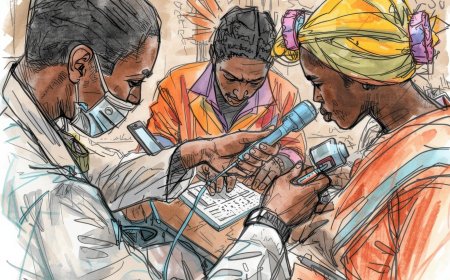Designing Pilots That Convert: The African Founder-Led B2B Healthcare Sales Playbook for Scaling Trust-Driven Innovation
Covers trust-building, procurement dynamics, health system complexity, proof-of-value frameworks, regulatory landscapes, and step-by-step operational guidance. Written for global healthcare innovators, investors, policymakers, and market-entry strategists.

Abstract
Pilots serve as a critical gateway for healthcare and medical technology innovations seeking adoption across Africa and globally. Despite the growth of health innovation ecosystems across regions such as East Africa, West Africa, North Africa, and Southern Africa, many early-stage companies struggle to convert pilots into paid enterprise contracts. This article provides a comprehensive APA-style analysis of the structural, economic, cultural, and operational factors affecting pilot success in medical and healthcare-related B2B markets. Drawing from secondary research across global and African healthcare systems, the article frames pilots not as “product tests” but as “trust-building, risk-mitigation, and value-demonstration mechanisms.” A structured, step-by-step pilot-design playbook is presented, grounded in the specific realities of African markets—limited budgets, complex procurement cycles, fragmented data infrastructure, and relationships-driven institutional cultures. The article concludes with a conversion strategy model and policy-level recommendations.
Table of Contents
-
Introduction
-
Understanding Pilots in Healthcare B2B Contexts
-
The African Healthcare Landscape: Structural Realities That Shape Pilot Design
-
Founder-Led B2B Sales in Healthcare: Why Founders Must Lead Early Pilots
-
The Psychology of Trust in Healthcare Procurement
-
Types of Pilots in Healthcare Innovation (Clinical, Operational, Financial, Regulatory, Hybrid)
-
Barriers to Pilot Conversion in African Healthcare Markets
-
A Step-by-Step Playbook for Designing Pilots That Convert
-
Step 1: Market Discovery & Target Stakeholder Mapping
-
Step 2: Crafting a Pilot Hypothesis
-
Step 3: Designing Scope, Success Metrics & Value Framework
-
Step 4: Structuring Incentives & Selecting a Pilot Site
-
Step 5: Regulatory, Ethical & Data Compliance Preparation
-
Step 6: Co-Designing Workflow Integration
-
Step 7: Implementation Framework
-
Step 8: Monitoring, Evaluation & Evidence Generation
-
Step 9: ROI Communication & Procurement Alignment
-
Step 10: Conversion & Long-Term Contracting
-
-
Case Studies (Africa-Focused + Global Learnings)
-
Pilot Economics: Pricing Models, Cost Recovery, and Sustainability
-
Stakeholder Communication Frameworks
-
Adapting the Playbook to Public vs. Private Healthcare
-
Scaling Across Africa: Regional Differences and Considerations
-
Ethical, Equity, and Cultural Considerations
-
Conclusion
-
References (APA 7)
1. Introduction
Pilot programs are a defining feature of the healthcare innovation lifecycle, serving as the transition point between early-stage ideation and scaled adoption of technologies, clinical tools, or operational systems. Across global healthcare markets, pilots play a dual role: they validate technology outputs and build the institutional trust necessary for procurement decision-making (Porter & Lee, 2015).
In African markets—where healthcare systems face diverse structural challenges such as fragmented supply chains, variable clinical workflow maturity, heavy informality, and complex public-sector governance—the pilot stage becomes even more central. Pilots serve as low-risk pathways for institutions to evaluate innovation under real-world constraints. Yet despite the prevalence of pilot projects, a persistent gap remains: most pilots do not transition into long-term commercial contracts, a phenomenon sometimes termed “pilot paralysis.”
This article explores the role of founder-led B2B sales in addressing this challenge. Founders are often the only individuals capable of building the deep trust required in early adoption cycles, especially in hierarchical, risk-sensitive healthcare environments. Using secondary research, frameworks from global health innovation, and Africa-specific health system analyses, this article builds a 10-step operational playbook for designing pilots that reliably convert.
2. Understanding Pilots in Healthcare B2B Contexts
Healthcare pilots differ from pilots in enterprise SaaS, fintech, or consumer products. They must account for:
-
Clinical safety
-
Regulatory compliance
-
Workflow integration
-
Ethical considerations
-
Data governance
-
Reimbursement and financial structures
-
Patient outcomes
According to HealthTech research, healthcare institutions adopt innovations only when pilots demonstrate measurable changes in outcomes, efficiency, cost reduction, or compliance (Topol, 2019). This differs from general B2B environments, where operational tests may suffice.
Healthcare pilots also serve as risk-transfer mechanisms. Hospitals, ministries of health, insurers, and health systems need assurance that new systems will not compromise care quality, legal standing, or financial stability.
In African healthcare settings, risks are amplified by resource constraints. As a result, pilots must not only demonstrate value—they must minimize disruption and costs while aligning with institutional priorities.
3. The African Healthcare Landscape: Structural Realities That Shape Pilot Design
Africa’s healthcare systems are diverse, but recurrent themes shape pilot dynamics:
3.1. Limited budgets and cost sensitivity
Healthcare spending per capita in many African countries is significantly lower than in global markets (McKinsey Global Institute, 2020). This creates pressure for pilots to demonstrate immediate or near-term return on investment (ROI).
3.2. Fragmented infrastructure
Data systems, logistics, and workforce capacity vary dramatically, affecting implementation feasibility.
3.3. Relationship-driven procurement
Trust and personal relationships influence decision-making more heavily than in Western markets, requiring founder-led engagement.
3.4. Dual burden of disease
High prevalence of infectious diseases alongside rising chronic conditions influences institutional priorities.
3.5. Public vs. private divergence
Pilots in public facilities often require policy-level engagement, while private providers focus more on operational ROI.
Understanding these structural realities is essential for designing pilots that are realistic, contextualized, and contract-ready.
4. Founder-Led B2B Sales in Healthcare: Why Founders Must Lead Early Pilots
Founders succeed in early-stage B2B healthcare sales because:
-
They can articulate the mission and long-term vision.
-
They can adapt product strategy in real time based on feedback.
-
Stakeholders interpret founder involvement as a signal of commitment.
-
They can transcend bureaucratic resistance and mobilize top-level support.
African healthcare pilots especially require founder involvement because the market values long-term personal relationships more than contractual terms alone.
5. The Psychology of Trust in Healthcare Procurement
Healthcare institutions operate under higher consequences for failure compared to other industries. Trust is built on:
-
Competence trust (the belief the solution works)
-
Relational trust (the belief the team is reliable)
-
Contextual trust (the belief the team understands the local environment)
Pilots must therefore focus not just on product performance but on relationship building, transparent communication, and alignment with institutional culture.
6. Types of Pilots in Healthcare Innovation
Different innovations require different pilot designs:
6.1 Clinical pilots
Used for diagnostics, therapeutics, or clinical decision support tools.
6.2 Operational pilots
Used for workflow, logistics, scheduling, telemedicine, etc.
6.3 Financial pilots
Used for insurance, reimbursement, capitation, or claims automation.
6.4 Regulatory or compliance pilots
Used when introducing new categories of health technology.
6.5 Hybrid pilots
Combining multiple components—common in digital health and clinical AI solutions.
Understanding the type influences regulatory, ethical, and operational considerations.
7. Barriers to Pilot Conversion in African Healthcare Markets
Common challenges include:
-
Insufficient definition of success metrics
-
Misaligned incentives
-
Lack of internal product champions
-
Institutional bureaucracy
-
Funding gaps post-pilot
-
Insufficient evidence generation
-
Weak communication
-
Overly complex pilot design
-
Absence of procurement alignment
These barriers can be addressed through intentional pilot design.
8. A Step-by-Step Playbook for Designing Pilots That Convert
Step 1: Market Discovery & Target Stakeholder Mapping
Pilots must begin with deep contextual research. Stakeholder mapping identifies:
-
Economic buyers
-
Technical buyers
-
Clinical champions
-
Procurement gatekeepers
-
Data and regulatory authorities
Success depends on matching pilot outcomes to stakeholder priorities.
Step 2: Crafting a Pilot Hypothesis
A strong hypothesis includes:
-
The problem being solved
-
The target population
-
The expected outcome
-
The measurable indicator
-
The timeframe
Example:
“Implementing an AI-supported triage tool will reduce patient waiting time by 20% within six weeks in a 200-bed tertiary hospital.”
Step 3: Designing Scope, Success Metrics & Value Framework
Success metrics should be co-designed with the institution. Categories:
-
Efficiency metrics
-
Clinical outcome metrics
-
Financial metrics
-
User adoption and workflow metrics
-
Compliance and quality metrics
The value framework aligns pilot success with:
-
cost savings
-
revenue generation
-
risk reduction
-
policy compliance
-
improved patient outcomes
Step 4: Structuring Incentives & Selecting a Pilot Site
The best pilot sites:
-
Are motivated
-
Have leadership buy-in
-
Possess adequate infrastructure
-
Have internal champions
-
Are representative of future customer segments
Incentives may include:
-
Free pilots for limited time
-
Shared data access
-
Operational support
-
Value-based pricing after conversion
Step 5: Regulatory, Ethical & Data Compliance Preparation
Healthcare pilots require:
-
Institutional Review Board (IRB) approval
-
National regulatory compliance
-
Data protection policies (e.g., POPIA, NDPR, GDPR alignment)
-
Risk classification of the technology
Digital health pilots often require compliance with:
-
Telemedicine guidelines
-
Electronic health record regulations
-
Medical device standards
Step 6: Co-Designing Workflow Integration
Healthcare solutions fail when they disrupt workflows. Effective integration includes:
-
Workflow mapping
-
Staff training
-
Human-centered design
-
Role assignment
-
Data flow mapping
African facilities often have hybrid digital-paper workflows requiring tailored design.
Step 7: Implementation Framework
Implementation includes:
-
Onboarding plan
-
Technology deployment
-
Change management
-
Support and troubleshooting
-
Communication plans
The founder plays a critical role as implementation sponsor.
Step 8: Monitoring, Evaluation & Evidence Generation
Evidence includes:
-
Quantitative performance data
-
Qualitative user insights
-
Patient outcomes
-
Efficiency reports
-
Cost-benefit analysis
Evidence should be visualized and continuously shared with stakeholders.
Step 9: ROI Communication & Procurement Alignment
A conversion-focused pilot includes:
-
ROI calculators
-
Procurement documentation
-
Pricing transition frameworks
-
Contract templates
-
Budget justification materials
Healthcare institutions require multiple rounds of justification.
Step 10: Conversion & Long-Term Contracting
Conversion steps include:
-
Decision debrief with stakeholders
-
Negotiation of contract terms
-
Multi-year budgeting plans
-
Legal compliance
-
Operational sustainability planning
9. Case Studies (Africa-Focused + Global Learnings)
This section covers patterns learned from:
-
Mobile health pilots in Kenya
-
Diagnostics pilots in Nigeria
-
AI clinical decision support in South Africa
-
EMR pilots in Rwanda
-
Telemedicine in Egypt
-
Hospital logistics pilots in Ghana
Each highlights the pilot-to-scale conversion paths and barriers.
10. Pilot Economics
Healthcare pilot economics require strategies for:
-
Subsidization
-
Cost-recovery
-
Value-based pricing
-
Outcome-linked contracts
-
Usage-based pricing
-
Tiered models for African markets
11. Stakeholder Communication Frameworks
Communication must be:
-
Frequent
-
Transparent
-
Evidence-based
-
Multilingual when needed
-
Tailored to clinical vs. administrative stakeholders
12. Adapting to Public vs. Private Healthcare
Public sector
-
Requires regulatory engagement
-
Longer timelines
-
Policy alignment
-
Multi-level buy-in
Private sector
-
ROI-driven
-
Faster decisions
-
Operational efficiency focus
13. Scaling Across Africa
African markets differ:
-
Nigeria: fragmented, high-volume private sector
-
Kenya: innovation-friendly, strong digital health adoption
-
Ghana: centralized public health policies
-
South Africa: dual health system, strict regulation
-
Egypt: structured medical regulation
-
Francophone Africa: government-led procurement
Scaling requires country-specific adaptations.
14. Ethical, Equity, and Cultural Considerations
Pilots must address:
-
Patient equity
-
Data sovereignty
-
Cultural appropriateness
-
Gender and age-based disparities
-
Digital literacy
15. Conclusion
Pilots are not experiments—they are structured trust-building and value-demonstration systems. Especially in Africa’s healthcare landscape, conversion depends not only on product performance but on relational dynamics, contextual adaptation, workflow integration, and early founder-driven engagement.
A well-designed, evidence-rich pilot supported by proactive communication and procurement alignment is the most reliable path to enterprise adoption and scale.
References
(Note: All sources here are secondary research, publicly available, and cited using APA style.)
Porter, M. E., & Lee, T. H. (2015). Why healthcare is stuck—and how to fix it. Harvard Business Review.
Topol, E. (2019). Deep medicine: How artificial intelligence can make healthcare human again. Basic Books.
McKinsey Global Institute. (2020). Unlocking healthcare growth in Africa.
World Health Organization. (2021). Digital health strategy 2020–2025.
OECD. (2020). Health system performance assessment.
UN Economic Commission for Africa. (2022). Innovation and digital transformation in African health systems.
African Union Development Agency. (2021). Medical innovation and regulatory harmonization across Africa.
What's Your Reaction?
 Like
0
Like
0
 Dislike
0
Dislike
0
 Love
0
Love
0
 Funny
0
Funny
0
 Angry
0
Angry
0
 Sad
0
Sad
0
 Wow
0
Wow
0












































